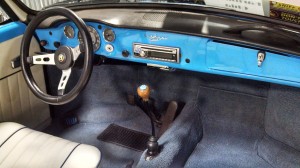Touch-Up Paint for Cars
Horror of all horrors. You come out of the grocery store and see a scratch in your car’s paint – no certified car nut can take this. It makes me sick to my stomach. But that’s your favorite car nut talking. In this article I will cover several methods I have used to remove minor surface scratches and scuffs. Car scratch repair can be done with a power buffer, hand polishing, wet sanding and touch-up painting. I will cover both professional and at-home tricks and tips. Don’t worry – many times a scratch isn’t the end of the world for us car nuts.
How Today’s Cars are Painted – It’s all About the Layers
To begin learning about scratch repair, it is important to understand how modern cars are painted. Today’s paint jobs consist of three coats. First there is a layer of primer. This is covered by coats of colored paint. On top of this is a layer of clear paint. This is called base coat or clear coat. The biggest advantages of this method are a superior deep shine and durability. This type of paint is very resistant to fading from exposure to the sun and nature’s elements.
Car Paint Scratch Repair
I want to begin by covering the most common types of scratches. These are minor scratches and light scuffs that are confined to the top clear coat layer of your paint job. Scratches that go too deep into the color layer or down to the underlying primer require more in-depth techniques that I will cover later in this post.
Paint Touch-Up Methods for Minor Scratches
The first thing to do when you get a scratch is to gauge its depth. Run your fingernail across it. If you can really catch your nail in the scratch, it could require some heroic measures to remove. For starters, let’s consider a minor scratch that you can just barely feel with your fingernail.
At my detail shop we would tackle surface scratches like this with a power buffer, a foam buffing head and some clear-coat buffing compound. This works extremely well but requires a great deal of practice and knowledge to accomplish at home. However, today there are some incredible products you can purchase to use at home – without needing a power buffer and everything that comes with it.
Today’s Wonder Polishes
There are hand polishing compounds that you can use to rub out the scratches. A couple of my favorite ones are Nu Finish Scratch Doctor, Turtle Wax Scratch Repair and 3M Scratch Remover Polish. These compounds work by leveling out the paint – smoothing the scratch out so that it removes the sharp edge. This makes it almost invisible to the eye. If your scratch is minor, you won’t even be able to catch your fingernail in it. Just be sure not to rub with too much pressure or over one spot too long. You don’t want to go all the way through the clear coat.
Deep Scratches That Require Paint Touch-Up
Now let’s go over how to get out deeper scratches. At the detail shop, if the scratch was too deep to get out with a buffer, we would use some wet/dry sandpaper. The wet sandpaper is rubbed over the scratch to get down to a clean layer of paint below. It levels out the paint in the scratched area. In some cases a little power buffing is then needed. It is very helpful to mix up a little soap and water to soak the sandpaper in before you begin. This acts as a lubricant. If you are in any way leery of this then head to a detail shop. The next step is to rub out the now dulled paint so it shines like the rest of the car. You can buy some mild car polish at just about any auto parts or auto paint shop.
Paint Touch-Up Kits
There are now some complete kits you can buy for removing scratches. One of my favorites is the Turtle Wax Scratch Repair Kit. This kit includes four grades of wet/dry sandpaper, polishing compound, and a tube of clear coat paint. On scratches that are all the way through the clear coat but not the color coat, you can use this clear touch-up paint to fill the gaps. By using the touch-up paint stick, you will fill in the scratch with clear paint so it will disappear to the eye.
Dealing With Serious and Deep Scratches
What if the scratch is down to the primer or even down into the metal? There is still hope. You need to go to your car dealer or an auto parts store and pick up a touch-up paint kit. This consists of a tube of color-matched paint and a tube of clear paint. Simply apply a thin layer of the colored paint, allow it to dry for 30 minutes, and then apply the clear paint. This works pretty well. To make the job look even better, go over the new touch-up paint with some clear-coat polishing compound to really smooth it out. It makes the repair very hard to notice. One thing, I like to use a very thin paint brush – the kind you would use on model cars – go to any hobby shop and you should find what you need.
Tips for Automotive Touch-Up Paint Methods
One trick I used at my detail shop included the use of masking tape. Before we started putting on any touch-up paint we applied masking tape right up to the edge of a scratch. Tape off both sides of a scratch – leaving just the gap where the paint is missing. This prevents you from putting too much paint on the surrounding areas – leaving the touch-up paint only in the wound. Remove the masking tape about a minute after you apply the touch-up. You don’t want the paint to dry the tape to the car. One quick tip: Use blue painter’s tape for this. It is available wherever they sell house paint. It doesn’t leave any glue behind on the car.
The next step is to go over the freshly painted area with a thin coat of clear paint. Once again, I normally waited at least half an hour for the colored paint to dry. Once the paint had dried, we would hand rub it with a soft towel and some polishing compound – Mequiar’s Machine Glaze Number 3 works great.
You can also purchase matching touch-up paint in aerosol cans from companies like Dupli-Color. I prefer the hand touch-up method over spray painting because you don’t have to worry about overspray getting on the rest of the car. But on large areas it can be a big help.
Once the scratches have been either hand rubbed, power buffed, wet sanded or touched up, it is time to rub out the area with some clear-coat compound. Next, apply a coat of wax so the area you have worked on shines like the rest of the car.
Now we have covered the various ways to remove scratches – it all depends on how deep they are. No matter which one you choose, it will always look better than an ugly scratch on your baby.



